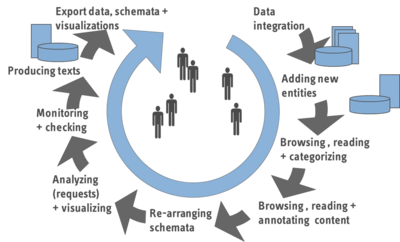Semantic CorA for Researchers
The virtual research environment Semantic CorA aims at enhancing research by supporting the research life-cycle. The main capacities of Semantic CorA are described below:
Importing Research Data
Research objects such as large digitalized corpora (in our use case educational lexica) are often hosted by a source such as a digital library and have to be imported into the vre. In our use case we developed a java-based application which addressing the OAI-PMH Interface of the digital library. For each part of the lexicon (lexicon, volume, lemma, image file) a wiki-page has been created. For a manual import of further lexicon we developed the extension OfflineImportLexicon to offer the researchers itself the capacity to design their corpus.
Browsing and Reading
Additionally to the data integration, browsing structures and reading possibilities can be realized within the vre. As it is possible to represent every entity as a wiki page, we created templates (a feature of MediaWiki), semantic forms (an extension of SMW) and ask-queries (a feature of SMW) to give a structured presentation and overview of the existing research data and annotations. Based on this we cvreated for example at our use case a data sheet and a table of content at each lexicon page. ((Insert: Example_TOC_Lexicon.gif)).
Enriching Research Objects (Annotation and Coding)
Further can the research objects be enriched by using different techniques. MediaWiki offers a possibility to categorize a wiki-pages by using the wiki-syntax ((insert example category: Person)). More specific annotations can be realized as properties with a feature of Semantic MediaWiki. Both possibilities can be supported by the creation of forms to reduce the technical barrier of using the wiki-syntax.
To use code a text For the annotation of images (or text in image-files) we developed the extension Semantic Image Annotator which allows the selection and annotation of retangular areas on images. As the values of the so called properties can be entities (e.g. wiki pages) themselves, all this coding and linking of the imported and created research objects leads to a semantic network of entities, created by the researcher.
Analyzing and Visualizing
Based upon the semantic network which was created, queries (through the usage of the SMW Query Language ASK) can be formulated and their results can be displayed as tables, maps, networks or bar diagrams.
Data Export, Sharing and Reuse
As the newly gained research data should be interoperable and shareable, SMW provides facilities to export query results to non-semantic formats such as JSON and CSV as well as RDF/XML. For the export in RDF/XML some well-known vocabularies like Friend-of-a-Friend (FOAF), the Bibligraphic Ontology (BIBO) or Simple Knowledge Organization System (SKOS) can be imported into the wiki. Their use allows the readily reuse and integration into other contexts (e.g. Linked Data).

